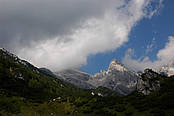Other Species
Hare (Lepus europaeus)
Habitat: it is widespread through Europe, it lives in the most varied of environments.
Identification: it is similar to the rabbit but differs due to the longer ears and the back legs, which are more developed and make it faster, as well as excellent at jumping (it can reach 80 km per hour for short periods). It is about 70 cm long, with thick red grey fur and a bob tail.
Reproduction: it is nocturnal. It digs underground dens. The female is ready for mating very early in life and give birth many times during the year.
Food: it mainly feeds on plants.
White Hare (Lepus timidus)
Habitat: it lives on the Alps, between 1000 and 3500 m in altitude.
Identification: it is given its name because in winter its coat becomes white, except for the tip of its ears. The animal reaches a length of about 70 cm. It is similar to the rabbit, but differs due to the longer ears and the back legs, which are more developed and give it the possibility of reach the remarkable speed of 80 km per hour for short periods. These animals have excellent eyesight and hearing.
Reproduction: it is nocturnal. It digs underground dens. The female is ready for mating very early in life and give birth many times during the year.
Food: it mainly feeds on plants.
Polecat (Mustela putorius)
Habitat: it is widespread in most of Europe and central-north Asia.
Identification: it has a slim body, about 60 cm in length, dark brown in colour, only a little lighter at the sides; a large snout, round ears, small eyes; its legs are breviplantigrade, with large claws; its tail is compressed. The main characteristic of this species is the presence of anal glands that excrete repellent substances when they feel threatened and as self-defence.
Reproduction: it is nocturnal, and lives in underground dens or in ravines in the rock. It gives birth to 4-5 small polecats that are blind and inept during the first few months of its life.
Food: it feeds on small rodents, reptiles, amphibians and sometimes it approaches inhabited centres where it endangers domestic animals (in this case chickens and rabbits).







